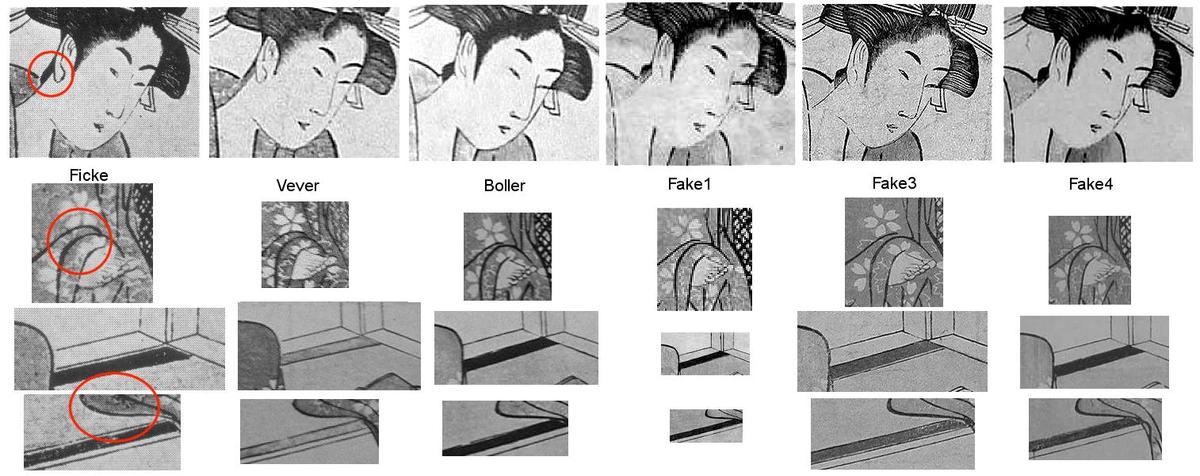
Title : Unknown, Bijin in robe
Artist : Kitagawa Utamaro
Date : Not set
Details : More information...
Source :
Japanese Art Open Database
Browse all 17129 prints...
Description : Comparison of repros and original. Some notes: 1. The hair in the neck of the courtisane is straight in the Ficke and in the Vever print, but curved in the other prints including the Bolller print. 2a. The curve over the left foot is more round and closes nicely on the Ficke and Vever print. The rest has a much straighter curver which doesn't touch any line at the right end. 2b. Above the curve on the Ficke/Vever print there is a good example of the flowery pattern which is quite different from the "fakes" and the Boller print. 4. The colored band in the corner of the veranda is enclosed by black outlines. In the Ficke print it "mismatches" and looks like there is a suggestion of depth. My previous assumption that this is a difference with the fakes proved to be wrong. The front edge of the veranda has the same mismatch. This mismatch also appeares (less visible) on the Boller print and "fake3". It's probably due to the shrinking of one woodblock or to a shaky hand of the printer. 5. The curve of the kimono at left is more round and goes more upwards at left compared too the more angular one on the "fakes" and on the Boller print. In all, I would conclude that it must be quite clear that there are two versions of the print from different blocks. The Ficke/Vever ones on one hand and the Boller/"fake" ones on the other hand. And I still think that the Ficke/Vever print is from the original blocks. While the other group was made for an audience that seeked "antique" prints with a great name and a certain age to them. Perhaps is not right to call the last group "fakes", but I still would very much like to see a good reproduction of a print of the first group. I think that such a print would put the copied version way behind . Theo de Kreijger The Vever picture is similar to the Ficke picture in terms of the 2 details you show (the folds and the curve above the foot), and, as in Ficke, there is no sign of the suspicious "fading" found on your "fakes". However, the color scheme is different (the long piece of garnment hanging around the legs is dark in Ficke (and in the "fakes" you show), but is lighter in Vever. There are also other differences in the Vever picture: the two dark lines along the back and front edges of the veranda are much lighter than in Ficke and the "fakes"; there is a crest printed on the fan; and there is some calligraphy on the "board" that appears to be hanging from the upper right corner of the print. The Boller picture, on the other hand, is very similar to your "fakes". As far as I can see, the two details (folds and the curve above the foot) appear identical to those found in the "fakes". There is even perhaps the beginning of the type of "fading" found on the "fakes", but it is much less visible than on the pictures you posted. There are other common features between the Boller picture and your "fakes": the top ends of the two long vertical folds on the dress around the leg hanging from the veranda are slightly curved, while they are straight in Ficke and in the Vever picture. Also, several irregularities (interruptions) on some straight lines (on the vertical lines of the "hanging board", the vertical beam at the corner of the veranda, and the bottom line where the base of the veranda meets the floor) exist in Boller and also, much more pronounced, on the "fakes". Similarly, the small interruption on the left lower part of the bowl is found both on the Boller picture and the "fakes". All this suggests to me that the Boller picture has been struck from freshly recarved blocks (some of the vertical lines are much sharper in Boller than in both Ficke and the "fakes"), and the "fakes" were produced later from the same recarved blocks, which by then were fairly worn. Philippe Callier: I am not sure we should necessarily conclude that the intention of the publisher or craftman who reproduced this print was to "deceive" the public. Here we had a popular design (and deservedly so), and the demand was there. Somebody tried to satify that demand, copying the model or recarving some of the blocks, as carefully and faithfully as possible. I prefer to call these pictures that are not from the original blocks "reproductions" rather than "fakes". I am grateful to these craftmen who made top quality copies, when they could of course have produced quickly, at a low cost, rough copies that would have sold anyway once the design has acquired the status of an icone. I believe I am not alone with this favorable opinion of the Meji copyists. Ficke,in his chapter discussing prints by Kaigetsudo, remarks: "Excellent full-size reproductions of several of them are obtainable. With these reproductions the ordinary collector will be obliged to content himself, for the whole number of Kwaigetsudo prints in existence can scarcely be more than a score or two" (Chats on Japanese Prints, page 83).
Download ImageDo you have a similar woodblock print to sell?
Get in touch with us for a preliminary estimate and for information in selling your woodblock print.
GET IN TOUCH